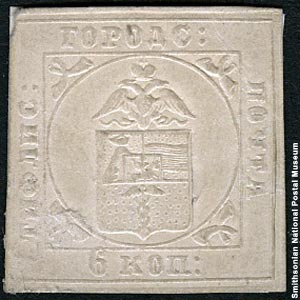Smithsonian’s National Postal Museum Launches “Russian Zemstvos: The G.H. Kaestlin Specialized Collection” Online Exhibit
The National Postal Museum’s collection of 14,000 Russian stamps includes exceedingly rare Imperial and Zemstvo Stamps. Russia was such a large country that pre-1917 there were two postal organizations: the postal service provided by the central government and “zemstvo post,” the mail service that functioned only in rural areas. The country-wide mail service served customers along ancient trade routes and later along railroad lines. However, this did not meet the needs of rural areas with no trade routes or railroad lines. To provide adequate service to these areas, country administrations called “zemstvo” took it upon themselves to establish local mail service and connect it with the mail service provided by the central government. The stamps can be viewed on the museum’s Arago online-exhibition website at http://postalmuseum.si.edu/ARAGORussianZemstvos.
Imperial Stamps were issued in czarist Russia between 1857 and the start of the Bolshevik Revolution in 1917 to allow for the safe delivery of documents during the reign of Czar Alexander II. They were used to collect postal fees to supplement and eventually replace the stamped prepaid envelopes used in Moscow and St. Petersburg as well as the wax or paper seals used on letters and packages from the mid-1700s. Thomas Lera, the museum’s Winton M. Blount Research Chair, said, “With varieties not known to exist within any other museum stamp collection in the world, these exceptional stamps reflect the culture and history of pre-revolutionary Russia.”
The first Imperial stamps were issued in December 1857 and sold initially in Russia and the Kingdom of Poland, and three months later in Siberia and Transcaucasia, including Tiflis. The stamp design had an oval center with the Imperial coat of arms, the double-headed eagle and the postal emblem of two crossed post horns. Also within the oval frame, “Pochtovaya Marka,” or post stamp, and “10 Kop: za lot” were written, designating the valuation of 10 kopecks per lot.
According to Lera, “Russian Zemstvos: The G.H. Kaestlin Specialized Collection” is one of the National Postal Museum’s most extraordinary international collections. The U.S. State Department’s Bureau of International Information Programs website, http://www.america.gov/russian_stamps.html, and its associated stamp galleries, along with the Arago online exhibit, http://postalmuseum.si.edu/ARAGORussianZemstvos, show only a glimpse of what is contained within its album pages.
The National Postal Museum is devoted to presenting the colorful and engaging history of the nation’s mail service and showcasing one of the largest and most comprehensive collections of stamps and philatelic material in the world. It is located at 2 Massachusetts Avenue N.E., Washington, D.C., across from Union Station. The museum is open daily from 10 a.m. to 5:30 p.m. (closed Dec. 25). For more information about the Smithsonian, please call (202) 633-1000. Visit the museum website at http://www.postalmuseum.si.edu.
# # #
SI-100-2011
Marty Emery
202-431-8963
emerym@si.edu

